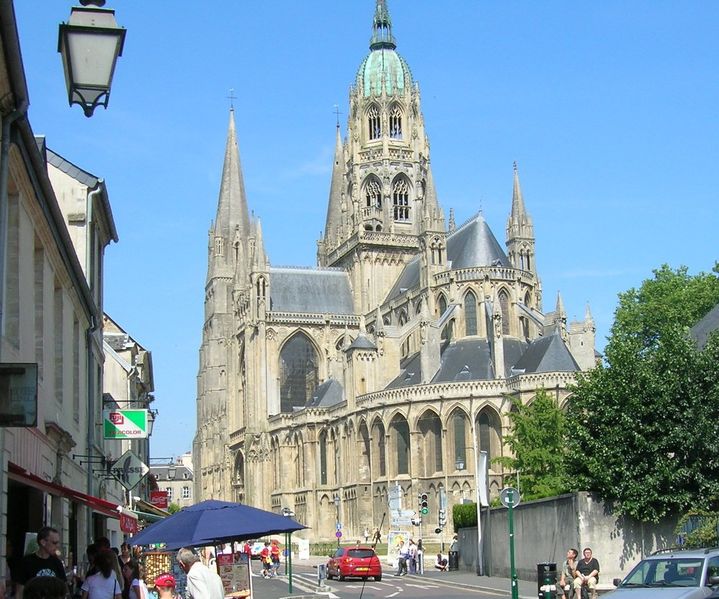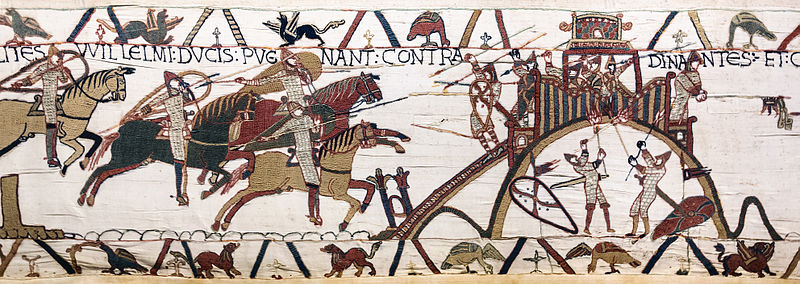According to the charming displaced Parisian couple who hosted us in their almost unrealistically adorable bed and breakfast, the medieval centre of Bayeux in Normandy, France, is so entirely well-preserved thanks to the unusually tall bell tower of the cathedral.
The story goes that the immense tower — which to this day dominates the area — afforded sentries of the occupying forces such an expansive and clear view of the battle-hardened Sherwood Rangers and their tanks approaching from sufficiently far away that the Germans were not only shown the wisdom of retreat but given the time to get every single soldier out of town without a shot being fired.
I don’t have a source that concretely verifies that, but it’s certainly true that Bayeux was the first French town liberated by the D-Day invasion and consequently the provisional seat of Charles de Gaulle’s first domestic government. It’s also so that Bayeux is a beautifully preserved city with so much pure charm they don’t really know where to put it all and it spills out into the surrounding countryside, making Bayeux the ideal command centre for a tour of the Normandy coast.
And a tour of the Normandy coast could mean a lot of things from the highly evocative castle of William the Conqueror to a visit to a distillery of the sharp and seductive local apple brandy Calvados, but I’m going to recommend a guided tour of the D-Day landing beaches. It’s inspirational and awe-inspiring and unless you were there it’ll probably also make you feel quite grateful and a little spoilt. Above Sword Beach, for example, you can view the still intact gun casemates that once housed massive German naval guns which pounded the beach and landing craft until it was taken by the Suffolk Regiment 1st Battalion in hand-to-hand combat.
Further west is Omaha Beach and arguably the toughest assignment, performed by US Rangers, Infantry and Marines, who crossed the beach under heavy machine gun fire, scaled a sheer cliffside under heavy machine gun fire, and knocked out the German artillery installation, under heavy machine gun fire. It helps to stand at the bottom of the 30 metre cliff to get a full appreciation for how difficult this would have been, with or without machine gun fire.
Many of the beaches still have the crossed-girder obstacles used as meagre shelter and the rusting hulks of the engineering miracle that is the floating docks remain where they were left 70 years ago after delivering their troops and jeeps and tanks and supplies. To understand the amazing logistics of the artificial harbour, your tour will probably include a visit to le Musée de l’Embarquement at Arromanches-les-Bains just above Gold Beach and it will definitely end with an eye-opening visit to one of the memorial cemeteries to get a notion of the immensity of the attrition that took place during the D-Day landings.
Of course Bayeux and the area are famous for another cross-channel invasion, that of the 1066 all-out assault by William the Conqueror to take the crown of England. The actual landing took place on the other side in the appropriately named Battle near Hastings in England but the story is told in primitive comic book chronology on the Bayeux Tapestry, beautifully curated at le Musée de la Tapisserie de Bayeux.
Technically, the Bayeux Tapestry isn’t a tapestry because tapestries are woven while the 70 metres of cloth known as the Bayeux Tapestry is embroidered, so it’s the Bayeux Embroidered Cloth. Another possibly uninteresting fact about the Bayeux Not-A-Tapestry is that it was made not in Bayeux nor even in France but in England by skilled English seamstresses who suddenly found themselves in 1070 to be skilled French seamstresses. But the unquestionably most amazing truth about it is that the colours and embroidery are still beautifully preserved after almost 1000 years.
The story unfurled in the fifty-odd scenes is largely told from the Norman perspective but is probably mostly true. A misunderstanding predicated on the final words of King Edward the Confessor led both Harold Godwinson and William the Conqueror to believe themselves to be the rightful king of England. Harold is even depicted travelling to Normandy with the dying king’s assurances so when he has himself crowned upon the Edward’s death William gathered all the soldiers and boats he could and set about doing that for which he was to become justifiably famous — conquering.
The importance of the artifact lends a visit a certain gravitas which is very nicely and thoroughly tempered by some eccentric touches introduced by the original craftswomen. Look out in particular for the clergyman apparently assaulting a woman in a frame bordered by two naked men dangling giant penises. And have a look at the first of two deaths of Harold and try to decide for yourself if in the first case he’s brandishing a spear or he’s just pulled an arrow from his eye.
A thousand years apart the two cross-channel invasions seem to never-the-less cohabit very nicely in Bayeux and its share of the beautiful Normandy coast. And the city itself remains an impeccably preserved and presented centrepiece with friendly innkeepers who tell charming stories explaining why.




